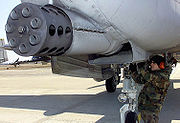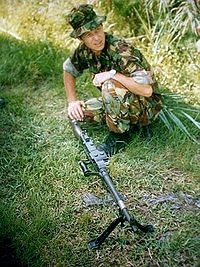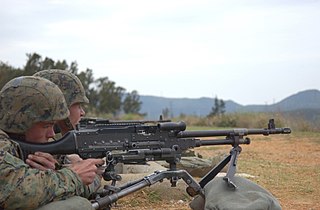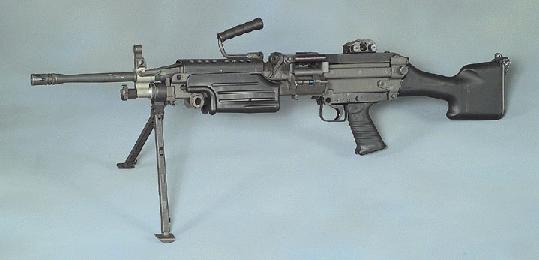One of the main reasons for the resurgence of the Gatling gun-style design is the weapon's tolerance for continuous high rates of fire. For example, if 500 rounds were fired at a high rate from a conventional single-barrel weapon, this would likely result in the barrel overheating (distorting in extreme cases) or a weapon jam. In contrast, a five-barreled Gatling gun-style weapon firing 500 rounds, only fires 100 rounds per barrel, an acceptable rate of fire. Ultimately the limiting factor is the rate at which loading and extraction can occur. In a single barrel design these tasks must alternate, a multiple barrel design on the other hand lets them occur simultaneously, with different barrels at different points in the cycle. Their high rate of fire also makes them useful in systems that have little time to engage their targets, such as CIWS which defend against fast-moving anti-ship missiles.
The M61 Vulcan 20 mm cannon is the most prolific member of a family of weapons designed by General Electric and currently manufactured by General Dynamics. It is a six-barreled rotary cannon capable of more than 6,000 rounds per minute. Similar systems are available ranging from 5.56 mm to 30 mm (there was even a 37 mm Gatling on the prototype T249 Vigilante AA platform); the rate-of-fire being somewhat inversely-proportional to the size and mass of the ammunition (which also determines the size and mass of the barrels).
Another Gatling design well-known among aviation enthusiasts is the GAU-8 Avenger 30 mm cannon, carried on the A-10 Thunderbolt II (Warthog) attack aircraft. It is a seven-barreled cannon designed for tank-killing and is currently the largest bore Gatling weapon active in the U.S. arsenal.
During the Vietnam War, the 7.62 mm caliber M134 Minigun was created as a helicopter weapon. Able to fire 6,000 rounds per minute from a 4,000-round linked belt, the Minigun proved to be one of the most effective non-explosive projectile weapons ever built and is still used in helicopters today.
They are also used on USAF AC-47, AC-119 and Lockheed AC-130 gunships, their original high-capacity cargo airframes able to house the items needed for sustained operation. With sophisticated navigation and target identification tools, Miniguns can be used effectively even against concealed targets. The crew's ability to concentrate the Gatling's fire very tightly produces the appearance of the 'Red Tornado' from the light of the tracers, as the gun platform circles a target at night.

The Minigun features in several action movies including Terminator 2 and Predator, but in reality they are unusable as unmounted personal weapons, the high rate of fire (with accompanying recoil), mechanical and power-supply complexity and heavy weight making them impractical compared to a light machine gun.




